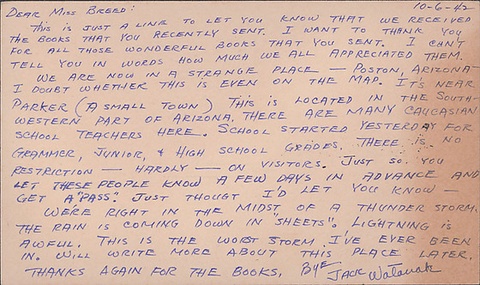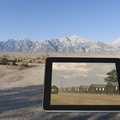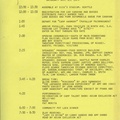I had been receiving a subscription to "Children and Books" for many years, and I was running low on the subscription fee, so I sent it to them. I had just received "Man's Search for Meaning" (by Viktor E. Frankl, translated by Kayoko Ikeda) from the University of Oregon library, which I had requested from my local public library. I wrote to the librarian saying how grateful I was that they had searched through libraries all over the United States for me and found it for me.

In response, Aoki Sachiko of the Children's Library Association said, "The story of the librarian in your letter is wonderful. It reminded me of a small column in the newspaper some time ago from an elderly woman. She said that she had been in a Japanese internment camp during World War II, and she wrote that she could never forget that a local librarian had delivered books to her while she was in the camp, and that she would love to meet that person again. It was a really small article, but it made me feel that the role of librarians is to provide service by handing out books to everyone equally, even (and especially) at times like these."
I didn't know that there was a book service in the Japanese internment camps.
What kind of interactions did the librarians have with the children? What kind of lives did the children lead? What kind of libraries were there in the concentration camps?
Since I started living in the United States, I have wanted to learn more about the internment camps, but I have been putting it off. With my grandmother's letter still haunting me, now is a good time to do so. I immediately began researching.
I would like to present this story in several parts. Chapter 1 covers the period up until the Japanese people were evicted from their homes, while Chapter 2 describes how temporary libraries were created in makeshift "assembly centers" built at racetracks and fairgrounds until the internment camps were built. Chapters 3 and 4 describe the beginning of life in the internment camps inland, where the climate is harsh. What kind of life did the children lead? The story is about the people who built the library from nothing and the people who supported them. Chapter 5 tells us what happened to each of these people afterwards.
Our guides are Henry from Seattle, Yoshiko from Berkeley, Jean from Guadeloupe, and "Mr. Breed's children" from San Diego. We hope to convey the voices of the children as they are, as much as possible.
*Reprinted from the 133rd issue (April 2013) of the quarterly magazine "Children and Books" published by the Children's Library Association.
Clara E. Breed Collection (Japanese American National Museum)
Please take a look at the letters written by the children that inspired this story.

© 2013 Yuri Brockett






